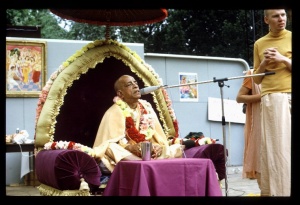CC Madhya 6.142 (1975): Difference between revisions
(Vanibot #0027: CCMirror - Mirror CC's 1996 edition to form a basis for 1975) |
(Vanibot #0020: VersionCompareLinker - added a link to the Version Compare feature) |
||
| Line 2: | Line 2: | ||
<div style="float:left">'''[[Sri Caitanya-caritamrta (1975)|Śrī Caitanya-caritāmṛta (1975)]] - [[CC Madhya (1975)|Madhya-līlā]] - [[CC Madhya 6 (1975)|Chapter 6: The Liberation of Sārvabhauma Bhaṭṭācārya]]'''</div> | <div style="float:left">'''[[Sri Caitanya-caritamrta (1975)|Śrī Caitanya-caritāmṛta (1975)]] - [[CC Madhya (1975)|Madhya-līlā]] - [[CC Madhya 6 (1975)|Chapter 6: The Liberation of Sārvabhauma Bhaṭṭācārya]]'''</div> | ||
<div style="float:right">[[File:Go-previous.png|link=CC Madhya 6.141 (1975)|Madhya-līlā 6.141]] '''[[CC Madhya 6.141 (1975)|Madhya-līlā 6.141]] - [[CC Madhya 6.143 (1975)|Madhya-līlā 6.143]]''' [[File:Go-next.png|link=CC Madhya 6.143 (1975)|Madhya-līlā 6.143]]</div> | <div style="float:right">[[File:Go-previous.png|link=CC Madhya 6.141 (1975)|Madhya-līlā 6.141]] '''[[CC Madhya 6.141 (1975)|Madhya-līlā 6.141]] - [[CC Madhya 6.143 (1975)|Madhya-līlā 6.143]]''' [[File:Go-next.png|link=CC Madhya 6.143 (1975)|Madhya-līlā 6.143]]</div> | ||
{{CompareVersions|CC|Madhya 6.142|CC 1975|CC 1996}} | |||
{{RandomImage}} | {{RandomImage}} | ||
==== TEXT 142 ==== | ==== TEXT 142 ==== | ||
| Line 27: | Line 26: | ||
<div class="translation"> | <div class="translation"> | ||
Śrī Caitanya Mahāprabhu continued, | Śrī Caitanya Mahāprabhu continued, " 'Whatever Vedic mantras describe the Absolute Truth impersonally only prove in the end that the Absolute Truth is a person. The Supreme Lord is understood in two features-impersonal and personal. If one considers the Supreme Personality of Godhead in both features, he can actually understand the Absolute Truth. He knows that the personal understanding is stronger because we see that everything is full of variety. No one can see anything that is not full of variety.' | ||
</div> | </div> | ||
| Line 34: | Line 33: | ||
<div class="purport"> | <div class="purport"> | ||
This is a quotation from Śrī Caitanya-candrodaya-nāṭaka (6.67), by Kavi- | This is a quotation from the Śrī Caitanya-candrodaya-nāṭaka (6.67), by Kavi-karṇapura. | ||
</div> | </div> | ||
Latest revision as of 18:33, 27 January 2020

A.C. Bhaktivedanta Swami Prabhupada
TEXT 142
- yā yā śrutir jalpati nirviśeṣaṁ
- sā sābhidhatte sa-viśeṣam eva
- vicāra-yoge sati hanta tāsāṁ
- prāyo balīyaḥ sa-viśeṣam eva
SYNONYMS
yā yā—whatever; śrutiḥ—the Vedic hymns; jalpati—describe; nirviśeṣam—impersonal truth; sā—that; sā—that; abhidhatte—directly describes (like a dictionary meaning); sa-viśeṣam—personality; eva—certainly; vicāra-yoge—when accepted by intelligence; sati—being; hanta—alas; tāsām—of all the Vedic mantras; prāyaḥ—mostly; balīyaḥ—more powerful; sa-viśeṣam—personal variety; eva—certainly.
TRANSLATION
Śrī Caitanya Mahāprabhu continued, " 'Whatever Vedic mantras describe the Absolute Truth impersonally only prove in the end that the Absolute Truth is a person. The Supreme Lord is understood in two features-impersonal and personal. If one considers the Supreme Personality of Godhead in both features, he can actually understand the Absolute Truth. He knows that the personal understanding is stronger because we see that everything is full of variety. No one can see anything that is not full of variety.'
PURPORT
This is a quotation from the Śrī Caitanya-candrodaya-nāṭaka (6.67), by Kavi-karṇapura.